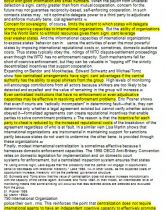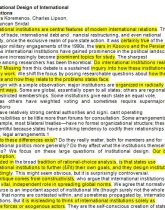Studijní materiál: The Rational Design of International Institutions
Skrýt detaily | Oblíbený- Kvalita:84,5 %
- Typ:Studijní materiál
- Univerzita:Univerzita Karlova v Praze
- Fakulta:Fakulta sociálních věd
- Kategorie:Humanitní vědy
- Podkategorie:Politologie
- Předmět:Teorie mezinárodních vztahů
- Autor:clean.bandit
- Ročník:3. ročník
- Rozsah A4:29 strán
- Zobrazeno:1 178 x
- Stažené:0 x
- Velikost:0,2 MB
- Formát a přípona:MS Office Word (.doc)
- Jazyk:anglický
- ID projektu:9400
- Poslední úprava:16.01.2017
Barbara Koremenos, Charles Lipson, and Duncan Snidal
International institutions are central features of modern international relations. This is true of trade, international debt and nancial restructuring, and even national security, once the exclusive realm of pure state action. It was certainly true of the two major military engagements of the 1990s, the wars in Kosovo and the Persian Gulf. As international institutions have gained prominence in the political landscape, they have increasingly become prominent topics for study. The sharpest debate among researchers has been theoretical: Do international institutions really matter? Missing from this debate is a sustained inquiry into how these institutions actually work. We shift the focus by posing researchable questions about how they operate and how they relate to the problems states face. We begin with a simple observation: major institutions are organized in radically different ways. Some are global, essentially open to all states; others are regional, with restricted memberships. Some institutions give each state an equal vote, whereas others have weighted voting and sometimes require supermajorities.
International institutions are central features of modern international relations. This is true of trade, international debt and nancial restructuring, and even national security, once the exclusive realm of pure state action. It was certainly true of the two major military engagements of the 1990s, the wars in Kosovo and the Persian Gulf. As international institutions have gained prominence in the political landscape, they have increasingly become prominent topics for study. The sharpest debate among researchers has been theoretical: Do international institutions really matter? Missing from this debate is a sustained inquiry into how these institutions actually work. We shift the focus by posing researchable questions about how they operate and how they relate to the problems states face. We begin with a simple observation: major institutions are organized in radically different ways. Some are global, essentially open to all states; others are regional, with restricted memberships. Some institutions give each state an equal vote, whereas others have weighted voting and sometimes require supermajorities.


